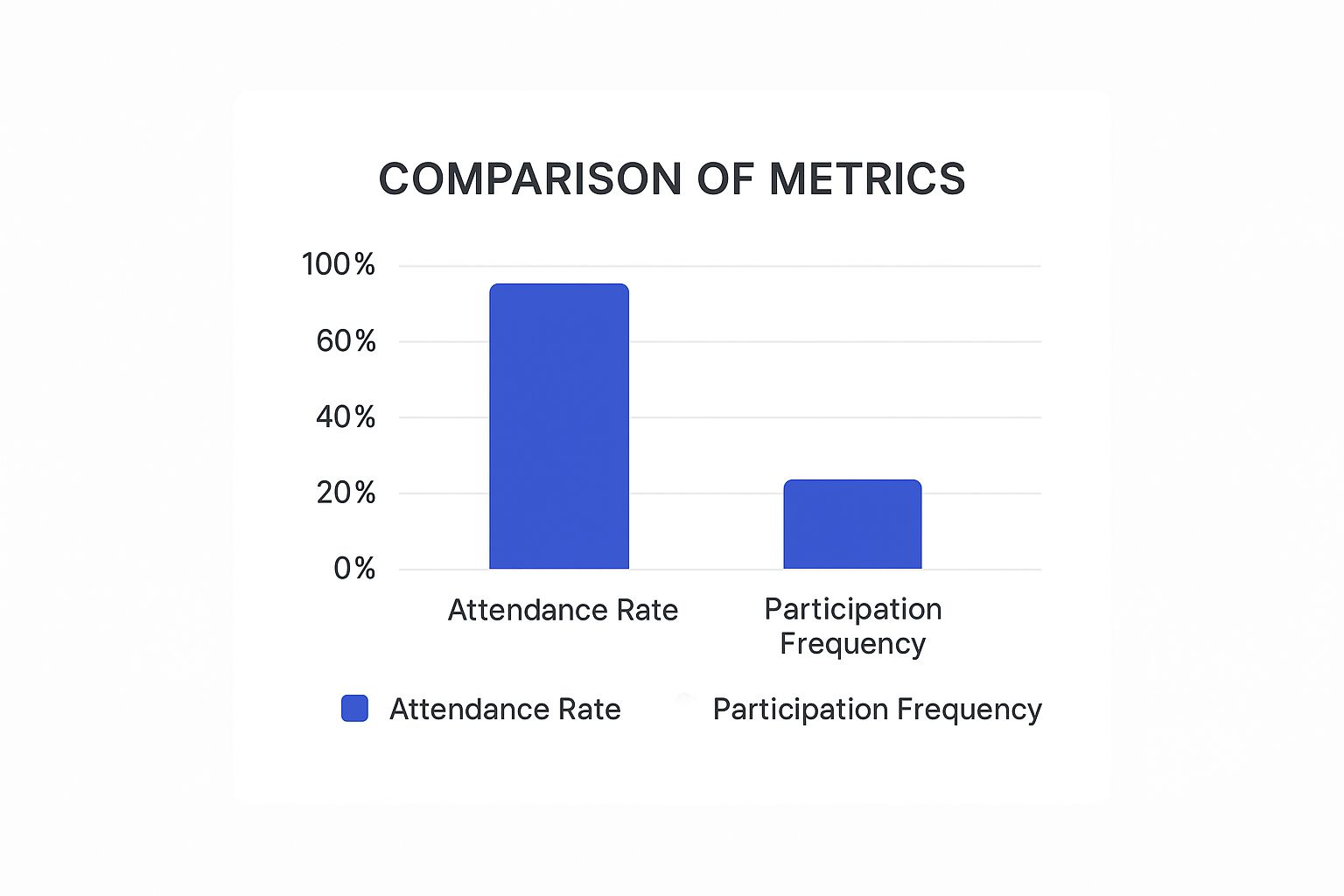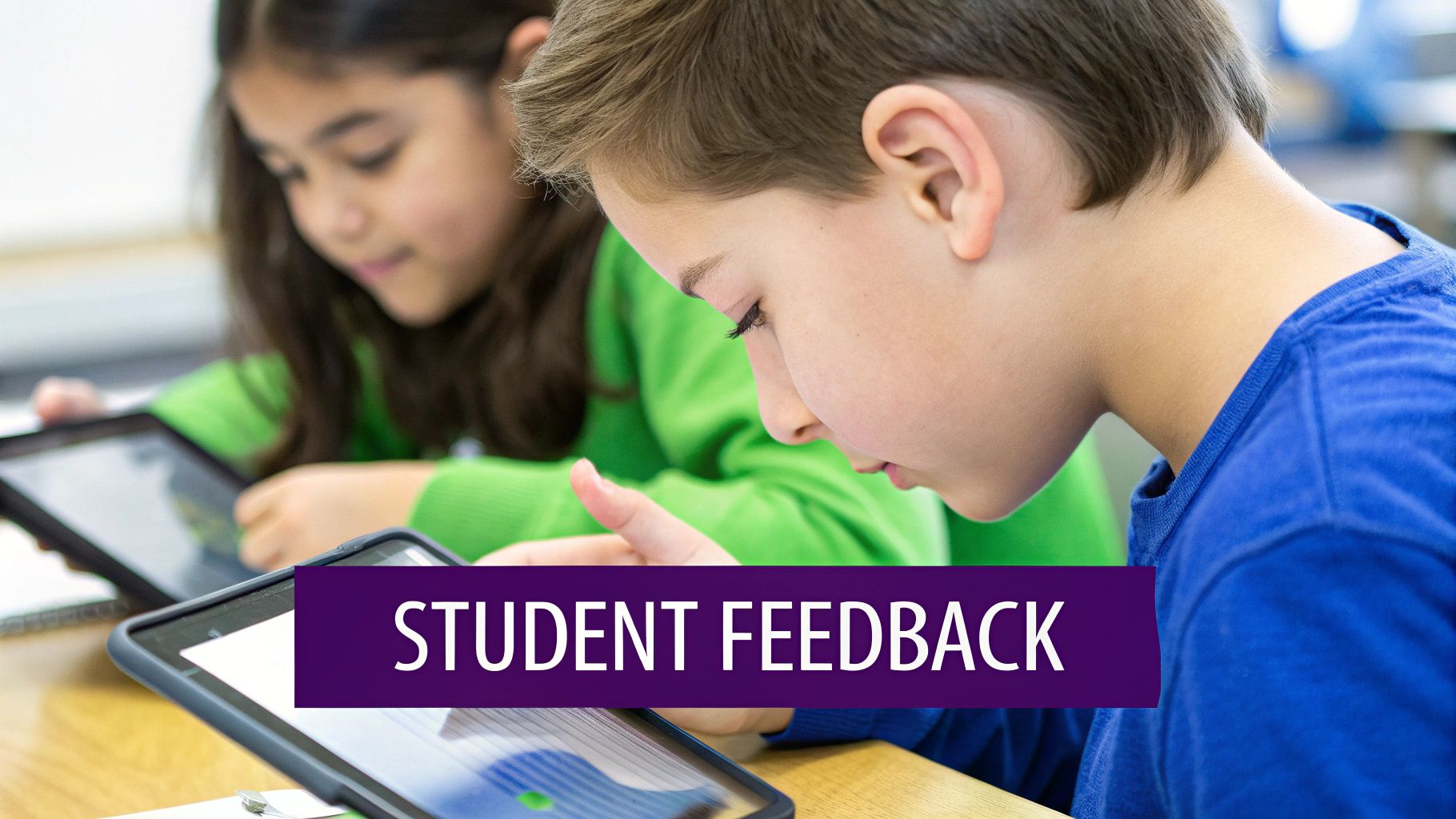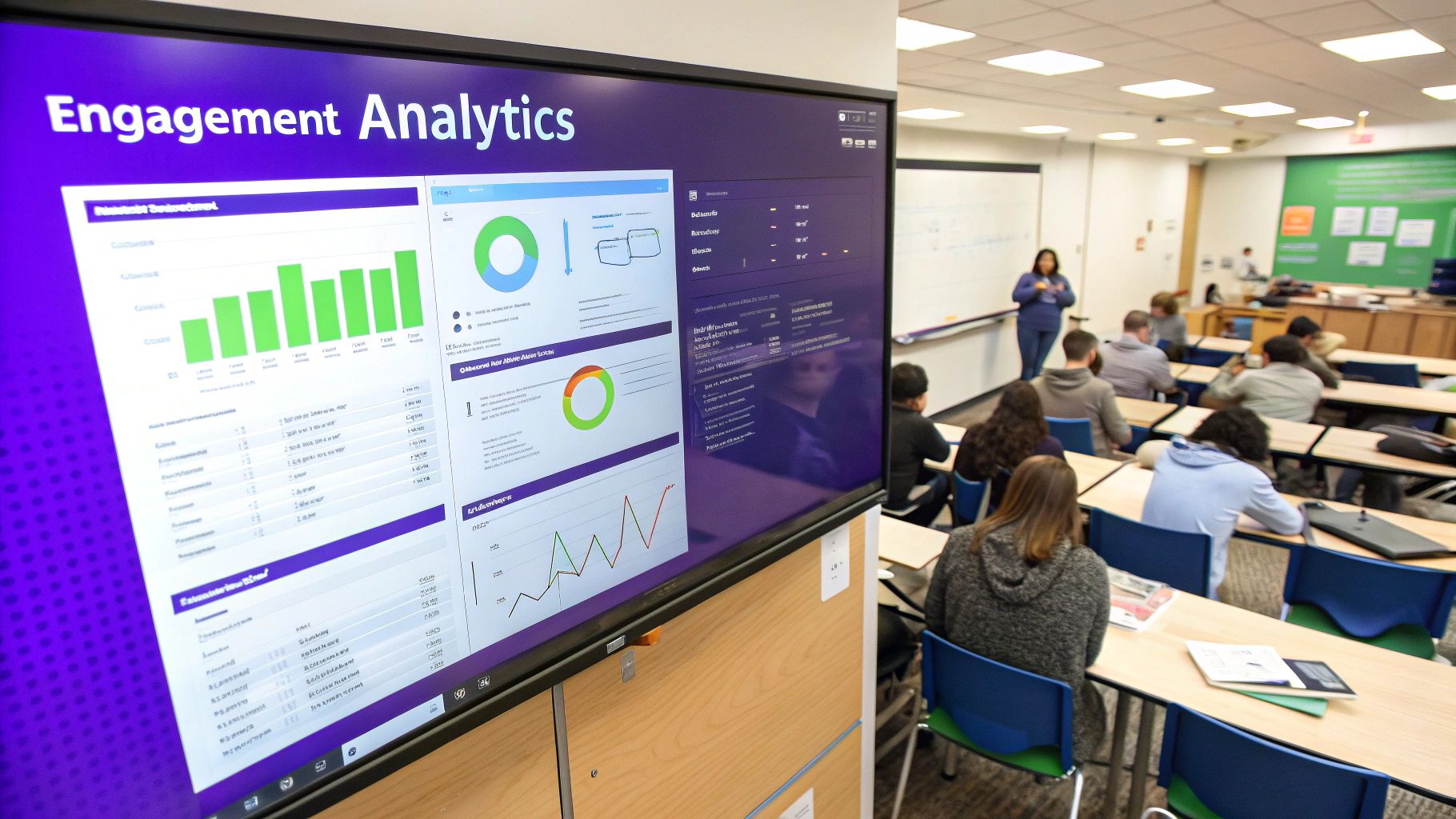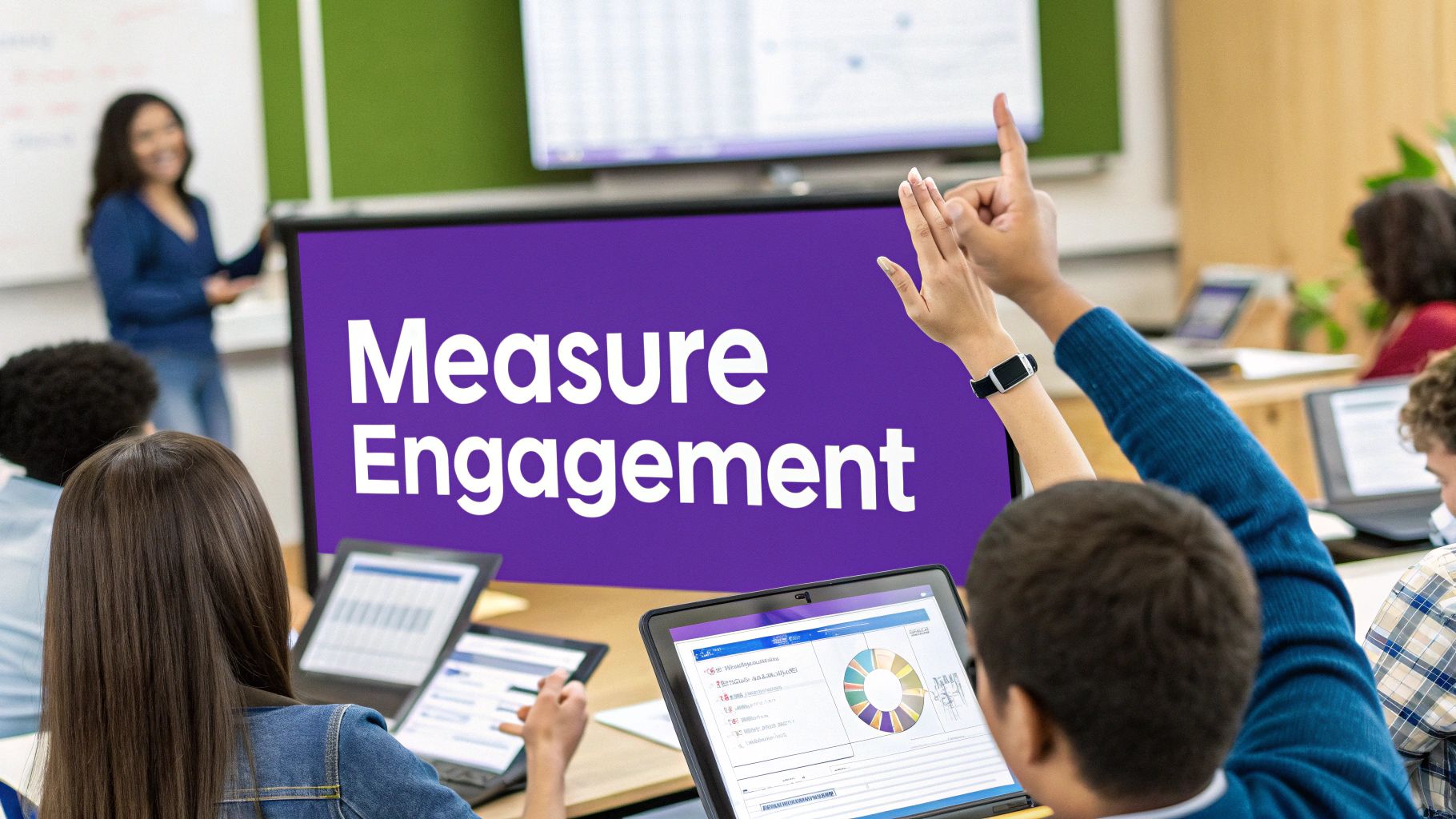Why Traditional Engagement Tracking Falls Short
Traditional methods of measuring student engagement often rely on superficial metrics like attendance and participation. While these factors provide some insight, they don't tell the whole story. Simply being present in class or raising a hand doesn't guarantee a student is actively learning and absorbing the material. This over-reliance on surface-level indicators leaves educators with an incomplete picture of student engagement.
This reliance on limited metrics means educators often miss crucial details about student motivation and genuine comprehension. It's like trying to understand a complex machine by only looking at a single gauge – you're missing the majority of the inner workings. A more nuanced approach is necessary to truly understand student engagement.
The Problem with Proxy Metrics
Attendance, for example, only confirms a student's physical presence, not their mental engagement. A student could be sitting in class but mentally miles away, lost in thought or distracted by something else entirely. This makes attendance a poor proxy for actual learning.
Similarly, participation, while valuable, can be misleading. Some students naturally contribute more to discussions, while others, even if deeply engaged, might prefer to listen and process information internally. This can create a skewed perception of engagement, overlooking valuable contributions from quieter students.
The Engagement Gap
Understanding the current state of student engagement is crucial. A recent report by LEGO Education found that only roughly one-third of U.S. administrators, teachers, and parents believe students are engaged in learning. Find more detailed statistics here. This statistic highlights a substantial gap between perceived and actual engagement.
Furthermore, the same report linked disengagement to increased absenteeism (47% of administrators) and behavioral issues (61% of teachers). This disconnect underscores the urgent need for more accurate and comprehensive engagement measurement tools. We need to go beyond simple metrics to truly understand the complexities of student engagement.
Recognizing the Subtle Signs
Traditional tracking methods frequently overlook subtle signs of disengagement. These can include a lack of eye contact, slumped posture, or a general disinterest in learning activities. Though seemingly small, these behaviors can indicate a student’s disconnect from the material.
By missing these cues, educators lose valuable opportunities for early intervention and support. This highlights the importance of adopting new strategies to better understand what truly motivates and engages students. We need to look beyond the surface to create a richer and more supportive learning environment.
Finding Metrics That Actually Matter
Measuring student engagement isn't just about checking attendance and participation. It's about understanding true intellectual curiosity and motivation. Many traditional metrics fail to capture this depth. Educators need to look beyond simple compliance to identify authentic engagement. For instance, a student might complete every assignment without truly understanding the material. This section will help you see the difference.
Beyond Compliance: Measuring Authentic Engagement
To truly understand student engagement, we need to consider both digital analytics and in-person observations. Digital tools, such as those featured in Key Tools for Online Educators, can track time spent on platforms and online discussion participation. But this is only part of the picture.
In-person observation lets educators see nonverbal cues like eye contact and posture – indicators digital tools often miss. Combining these approaches gives a more complete view of engagement.
We also need to distinguish between quantitative and qualitative data. Quantitative data, like test scores and assignment completion rates, offers measurable results. This data helps identify trends. Qualitative data, such as student feedback, provides context and helps understand the "why" behind student behavior. Both are crucial.
Schools use key metrics like time on task and participation rates, especially in virtual learning. Data analytics tools track how students interact with educational resources. A Gallup survey showed engaged students are 2.5 times more likely to report receiving a good education. Explore this topic further. Traditional methods often fall short. For more on marketing measurement limitations, see this article on campaign measurement.
Visualizing Engagement Data
The following infographic highlights the gap between traditional attendance and participation metrics.

The infographic compares average attendance with average participation frequency. While attendance stays high, participation is much lower. This suggests that many students, though present, aren't actively engaged. This emphasizes the need for metrics that measure true intellectual engagement, not just physical presence. By understanding these differences, educators can build learning environments that encourage genuine curiosity and deeper learning.
The following table provides a more detailed comparison of different student engagement metrics:
Key Student Engagement Metrics Comparison: A comprehensive comparison of different engagement measurement approaches, showing their effectiveness and implementation difficulty.
| Metric Type | Measurement Method | Effectiveness Score | Implementation Difficulty | Best Use Case |
|---|---|---|---|---|
| Time on Task | Digital tracking tools | High | Easy | Monitoring online learning activities |
| Participation Rates | Online discussion forums, polls | Medium | Easy | Assessing active involvement in virtual classrooms |
| Completion Rates | Assignment submissions | Medium | Easy | Tracking task completion |
| In-Person Observation | Teacher observation of nonverbal cues | High | Medium | Understanding student focus and attentiveness in physical classrooms |
| Student Feedback | Surveys, interviews, focus groups | High | Medium | Gathering qualitative insights on student experiences |
This table summarizes several key metrics for evaluating student engagement, offering a range of approaches from simple digital tracking to more nuanced in-person observations and feedback collection. Each method has its strengths and weaknesses, with varying levels of effectiveness and implementation difficulty. Combining multiple approaches offers a richer understanding of student engagement than relying on any single metric.
Navigating New Engagement Realities

The educational world has shifted. Simply tracking attendance and participation no longer provides a complete understanding of student engagement. Educators need fresh strategies to truly gauge how connected students are in today's learning environments. A student might attend every class and contribute to discussions, yet their mind could be miles away.
This disconnect poses a serious challenge for teachers striving to reach every student.
Identifying Hidden Disengagement
Recognizing hidden disengagement is key. This means identifying students who may appear involved at first glance, but are actually struggling to connect with the material. These students often slip through the cracks of traditional assessment methods.
Traditional systems, relying on observable metrics, miss the subtle cues of disengagement. These cues might include avoiding eye contact, a dip in the quality of work, or withdrawing from classroom interactions.
The rise of online and hybrid learning has further complicated measuring engagement. In digital spaces, it’s easier than ever for students to be physically present but mentally absent. A student might have their camera on during a virtual class while simultaneously engaging with social media or playing video games.
Student engagement has noticeably declined, particularly in the wake of the pandemic. A recent survey indicated 46% of teachers reported lower engagement compared to 2019. This decline is partly attributed to fewer opportunities for students to explore their curiosity, with 83% of teachers citing this lack of opportunity. Read the full research here. Understanding these evolving dynamics is crucial for educators committed to fostering true learning.
Embracing Innovative Measurement Approaches
To address these evolving challenges, educators need to adopt innovative measurement approaches. These strategies should move beyond surface-level observations to delve into the cognitive, emotional, and behavioral aspects of engagement.
Using open-ended questions, student reflections, and project-based assessments can offer valuable insights into genuine interest and comprehension.
These new approaches should also acknowledge diverse learning styles and student preferences. Incorporating technology to track student interactions with online resources, analyzing feedback, and observing collaboration during group projects can all contribute valuable data.
This holistic approach allows educators to develop a deeper understanding of each student and provide tailored support that promotes authentic learning and growth.
Tools That Work in Real Classrooms

Meaningful student engagement insights are crucial for educators navigating today's classrooms. This involves finding the right tools, not necessarily the most complex software. This section explores practical, high-tech and low-tech solutions to help educators paint a complete engagement picture without being overwhelmed by data. For those interested in online course creation, check out this resource: How to master creating online courses. Effective strategies for planning can be found in resources like this one discussing strategic planning for associations.
Simple Yet Powerful: Low-Tech Tools
Even with limited budgets, valuable engagement data is within reach. Simple observation protocols, such as checklists, can track specific behaviors and reveal much about student focus and participation. For instance, teachers can observe how frequently students contribute to discussions, ask questions, or engage in eye contact.
Another powerful low-tech tool is student self-reflection. Encouraging students to reflect on their learning journeys provides valuable insights into their motivations, challenges, and interests. This direct feedback helps teachers grasp the student experience from the student's perspective.
Leveraging Technology: High-Tech Tools
Technology offers powerful tools for measuring student engagement. Learning Management Systems (LMS), like Canvas, offer data on student interaction with online materials, assignment completion, and online discussion participation. This data helps teachers understand digital learning patterns.
Specialized student engagement platforms can provide even more granular insights. They track metrics like time spent on tasks, emotional responses, and collaborative patterns. This detailed information allows educators to identify struggling students and personalize learning experiences.
Combining Tools for a Comprehensive View
Many educators find success by combining various tools. A teacher might use observation checklists during class, supplement this with LMS data, and incorporate student self-reflections. This creates a multi-faceted view of each student's engagement.
This multi-pronged approach requires careful planning to ensure tools work together effectively. The goal is a holistic view of student engagement without increasing teacher workload. Streamlined data collection and analysis is key to making this approach manageable and insightful.
Choosing the Right Tools: Practical Considerations
The most effective tools are the ones you will consistently use. Consider these factors when selecting your tools:
- Your context: A tool suitable for a physical classroom might not work for online learning.
- Implementation Time: How long does implementation and training take?
- Resources: What is your budget for software and professional development?
To help you choose, the following table provides an overview of effective tools for gauging student engagement in various educational settings.
Engagement Measurement Tools by Setting
| Tool Category | Best for Environment | Key Features | Cost Level | Implementation Time |
|---|---|---|---|---|
| Observation Checklists | Physical Classroom | Tracks specific behaviors | Low | Quick |
| Student Self-Reflection | All Environments | Gathers student perspectives | Low | Quick |
| Learning Management Systems (LMS) | Online Learning | Tracks digital learning activity | Medium | Moderate |
| Student Engagement Platforms | All Environments | Provides in-depth engagement data | High | Moderate to High |
This table summarizes various tools for measuring student engagement across diverse educational environments. Selecting the right tool depends on your environment, desired features, budget, and implementation timeframe. The best tools integrate seamlessly into your existing workflow and provide actionable insights.
Turning Data Into Student Success

Collecting engagement data is just the beginning. The true power lies in using these insights to create positive changes for students. This involves transforming data into focused interventions that improve learning outcomes and build a stronger connection with education. How can educators achieve this?
Identifying At-Risk Students
Effective educators utilize engagement data to pinpoint students who might be struggling before they fall significantly behind. Think of it like a doctor using tests to catch early signs of a health issue. By studying engagement patterns, teachers can identify red flags like decreased participation or lack of interest in class activities. Early identification like this is key to implementing timely support.
For instance, if a student's online activity within a learning management system like Canvas or Moodle reveals diminished interaction and consistently late submissions, it might suggest disengagement. Combined with observations of withdrawn behavior in the classroom, this data gives the teacher a clear signal to reach out and offer assistance.
Adjusting Instruction Based on Feedback
Engagement data isn't solely for identifying at-risk students. It's also a valuable resource for refining teaching methods. Just as a chef tweaks a recipe based on feedback, teachers can modify their approach based on student engagement data. This creates a feedback loop for ongoing improvement in the learning experience.
This could mean introducing more interactive activities if data reveals students are disengaging during lectures. It could also involve adjusting the pace of instruction if data suggests students are feeling overwhelmed. Using data to make these changes helps create a more responsive and captivating learning environment.
Real-World Impact: Case Studies in Success
Real-world examples highlight the effectiveness of data-driven interventions. In one case study, a school used engagement data to identify students who weren't actively participating in online learning. By offering targeted support and personalized learning plans, they observed a significant improvement in both student performance and motivation.
Another example demonstrates the value of student feedback surveys in pinpointing areas where teaching could be enhanced. Addressing these concerns led to a noticeable rise in student participation and overall satisfaction.
Creating Effective Feedback Loops
Transforming data into student success hinges on establishing productive feedback loops. This involves consistently gathering engagement data, examining it for actionable insights, and then using those insights to inform changes in teaching strategies. It's a continuous cycle of measurement, reflection, and adjustment.
This process guarantees that data collection leads to meaningful improvements in the learning experience. This constant refinement is crucial for building a dynamic and adaptable learning environment that caters to the evolving needs of students. By embracing this approach, educators can make data-informed decisions that empower students to excel.
Building Systems That Last
Creating a sustainable system for measuring student engagement involves more than just initial enthusiasm. It requires a thoughtful, systematic approach integrated into your teaching practices. This section provides practical frameworks for building measurement systems that adapt and evolve alongside your changing needs. You might find this helpful: How to master community engagement strategies.
Training and Protocols: The Foundation of Consistency
Effective implementation of any new system hinges on proper training for your colleagues. This ensures everyone understands the why, what, and how of measuring student engagement. Consistent training builds a shared understanding of the system's purpose and its vital role in enhancing student learning.
Establishing clear protocols is equally important. These protocols act as a structured guide for gathering and interpreting engagement data. They offer a consistent approach to measurement, minimizing bias and ensuring reliable results over time.
Maintaining Momentum: Overcoming the Challenges
Sustaining momentum after the initial enthusiasm wanes can be a challenge. Actively recognizing and celebrating successes, both big and small, is essential. This helps maintain motivation and keeps everyone focused on the long-term goals.
Another common obstacle is adapting your approach to different learning environments. A system designed for a small classroom setting might require adjustments for larger groups or online learning. Flexibility and adaptability are crucial for successful implementation across diverse educational contexts.
Adapting and Refining Your System
No system is perfect from the outset. Continuous refinement is key to long-term success. Regularly evaluate your measurement system, and be open to adapting it based on the feedback and data you collect. This ongoing process ensures your system stays relevant and effective in measuring authentic student engagement.
Furthermore, celebrating achievements and acknowledging the effort involved in implementing and maintaining the system is vital. This reinforces motivation and encourages continued commitment to measuring student engagement. By following these guidelines, you can establish a robust and impactful system that yields meaningful results.
Your Engagement Measurement Action Plan
Creating a successful student engagement measurement plan requires a structured approach. This action plan provides a roadmap for implementing the strategies discussed earlier, focusing on realistic steps and achievable milestones. It's about building a system that provides valuable insights without becoming overwhelmed with data.
Prioritize and Implement
Begin with small, manageable steps. Don't try to do everything at once. Instead, concentrate on quick wins to build momentum.
-
Step 1: Choose One or Two Key Metrics: Instead of tracking everything, start by focusing on one or two metrics aligned with your specific needs. For example, consider focusing on in-class observation and student self-reflection.
-
Step 2: Select the Right Tools: Choose tools that are easy to use and appropriate for your environment. Simple observation checklists or readily available Learning Management System (LMS) data can be great starting points.
-
Step 3: Train Your Team: Make sure everyone involved understands how to use the chosen tools and how to interpret the data collected. Clear training is essential for consistent and accurate measurement.
Measure and Adapt
Regularly review your progress and adjust your approach as needed. This iterative process of measurement and adaptation is essential for long-term success.
-
Checkpoint 1: Data Collection: After a predetermined period, review the data gathered. Ask yourself if the chosen tools are providing useful information. Are there any gaps in the data?
-
Checkpoint 2: Intervention Implementation: Based on the data analysis, implement targeted interventions. Carefully observe how these changes influence student engagement. Look for both positive and negative impacts.
-
Checkpoint 3: System Refinement: Based on your observations, fine-tune your measurement system. This might involve introducing new metrics, switching tools, or improving training protocols.
Celebrate Success and Maintain Momentum
Recognize and celebrate progress, no matter how small. Celebrating successes helps build momentum and encourages continued commitment to measuring student engagement.
-
Short-Term Wins: Acknowledge improvements in individual student engagement or positive feedback regarding new teaching strategies. These small wins contribute to the larger goal.
-
Long-Term Goals: Celebrate significant achievements like improvements in overall class engagement or measurable increases in student performance. These milestones demonstrate the effectiveness of your efforts.
By following this action plan, you can develop a sustainable and effective engagement measurement system tailored to your particular needs. This system should be a dynamic tool that constantly evolves to provide the most relevant insights into your students' learning experiences.
Ready to enhance your Shopify store with online courses and community engagement? Discover how Tevello can seamlessly integrate digital learning and product sales.




